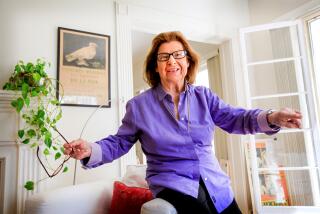Rose Hobart; SAG Official, Blacklisted Actress
- Share via
Rose Hobart, motion picture actress of the 1930s and 1940s whose career screeched to a halt after she was questioned by the House Un-American Activities Committee half a century ago, has died. She was 94.
Hobart died Tuesday at the Motion Picture and Television Country Home and Hospital in Woodland Hills, where she had lived since 1982.
For the record:
12:00 a.m. Sept. 9, 2000 For the Record
Los Angeles Times Saturday September 9, 2000 Home Edition Metro Part B Page 6 Metro Desk 2 inches; 55 words Type of Material: Correction
Actors Lab--The Aug. 31 obituary of blacklisted actress Rose Hobart noted that supporters of Sen. Joseph McCarthy considered the Actors Lab, which Hobart participated in, subversive. In fact, it was the House Committee on Un-American Activities, which called Hobart to testify in 1949, that considered the Actors Lab subversive. McCarthy did not begin to investigate communism until 1950.
“I remember when a casting director simply told me that I had been blacklisted,” she told The Times in 1991. “I was livid. I also knew I had done it to myself. I had spoken out against what I considered unfair treatment of people in Hollywood.”
When she was called before the Communist-baiting congressmen, Hobart was on the board of the Screen Actors Guild and was an active participant in Actors Lab, which supporters of Sen. Joseph McCarthy considered subversive.
“We were all liberals, as far as I was concerned,” Hobart said in 1986. “We felt people were more important than businesses.”
Even though Hobart had signed a paper stating that she was not and never had been a Communist, and even though she knew her purported signatures on Communist slogans brandished by the committee were bogus, Hobart was labeled.
“My career just stopped right there. I haven’t worked in the picture business since. That was 1949,” she said. “The word went out from the studios. There was a blacklist. There really was.”
Never bitter, Hobart always believed that she was blacklisted not because of any legitimate Communist connections but because of her agitation for better working conditions for actors.
She came to Hollywood in 1930 to star in Frank Borzage’s version of Ferenc Molnar’s “Liliom,” which had also been her first play. Seasoned on the Broadway stage, Hobart was appalled by Hollywood studio treatment of performers.
“On my first three pictures, they worked me 18 hours a day and then complained because I was losing so much weight that they had to put stuff in my evening dress,” she said in 1986. “When I did ‘East of Borneo’ (1931), that schlocky horror I did, we shot all night long. They started at 6 o’clock at night and finished at 5 in the morning. For two solid weeks, I was working with alligators, jaguars and pythons out on the back lot. I thought, ‘This is acting?’ It was ridiculous. We were militant about the working conditions. We wanted an eight-hour day like everybody else.”
The blue-eyed, dark-haired beauty appeared in more than 40 pictures in two decades, as a leading lady or the consummate “other woman.” In Humphrey Bogart’s “Conflict” in 1945, she was the wife he schemed to kill in order to romance her more alluring sister, played by Alexis Smith.
Born in New York to a cellist father and opera singer mother who were frequently away on tour, Hobart attended boarding schools. She developed an early fascination with the stage at the age of 6 when summering with her family in Woodstock, N.Y. The poet Edna St. Vincent Millay was living next door--in town for the production of perhaps the only play she ever wrote. The child followed the writer “like a puppy dog,” and the two had frequent talks.
At 15, Hobart was cast in the play “Liliom,” which opened in Atlantic City.
“On opening night, there was a knock on my door,” she recalled. “And Edna St. Vincent Millay walked in and said, ‘You made it!’ ”
Hobart debuted on Broadway in 1923 as the young girl in “Lullaby” and made her London debut in 1928 as Nona Rolf in “The Comic Artist.” During her theatrical years, she toured with Noel Coward in “The Vortex” and played opposite Helen Hayes in “What Every Woman Knows.” The performance that won her a Hollywood contract was as Grazia in “Death Takes a Holiday.”
Although Hobart rarely returned to acting after her HUAC debacle, she did make some television appearances in the 1960s. She was Sister Margaret on “The Danny Thomas Show” and the maid Mary on “Peyton Place,” and she had a few guest roles on series such as “Gunsmoke,” “Cannon” and “The FBI.”
Hobart also used her acting talents to record master tapes for the Braille Institute. She wrote articles for Science of Mind magazine and, after moving to the Motion Picture Country Home, was editor of its Haven News.
In 1988, a limited audience was delighted to find Hobart acting in a student film, “Rancho California” by Steven Ramiriz, shown at the Academy of Motion Picture Arts and Sciences.
In 1994, she wrote an autobiography, “A Steady Digression to a Fixed Point.” Although her last film was the 1949 “Bride of Vengeance,” she continued to receive fan mail until her death.
The actress and activist is survived by her son, Judson Bosworth, from her third marriage, to the late architect Barton H. Bosworth.
At Hobart’s request, no services are planned.
More to Read
The biggest entertainment stories
Get our big stories about Hollywood, film, television, music, arts, culture and more right in your inbox as soon as they publish.
You may occasionally receive promotional content from the Los Angeles Times.










